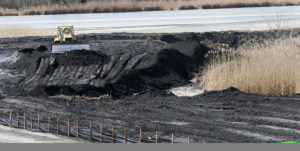Governor Ralph Northam has indicated his support for digging up 27 million cubic yards of coal ash, recycling some of it, and disposing of the rest in lined landfills far from Virginia’s rivers and streams. The cost has been estimated at $5.7 billion, adding an average $3.30 per month to the average household’s electric bill over 20 years.
“If not disposed of properly, coal ash can ruin water quality and create environmental disasters,” Northam said at a news conference yesterday, citing a 2014 coal ash spill in North Carolina. “We cannot have a repeat of that here in Virginia.” So reports the Richmond Times-Dispatch.
If Northam really said that, I shudder for the future of the commonwealth. There is so much misunderstanding packed into such a brief statement.
Maybe the governor has a keener grasp of the coal-ash issue than he let on. But when we’re discussing a potential $5.7 billion expenditure, Virginians have a right to expect the governor not to garble the message. As it is, one is left with the impression that Northam, who has incurred the wrath of environmentalists for his support of two natural gas pipeline projects, is throwing the environmental lobby a multibillion-dollar bone at rate payers’ expense.
Let’s dissect the statement.
First, Northam cited a 2014 coal ash spill in North Carolina, adding, “We cannot have a repeat of that here in Virginia.”
No one wants a repeat of the Duke Energy coal ash spill in 2014 that contaminated a stretch of the Dan River in Virginia. That’s precisely why the Environmental Protection Agency (EPA) enacted new regulations for preventing another spill, and why Dominion Energy moved quickly to comply with the regulations.
For decades it was standard practice for Dominion, like Duke and many other power companies, to dispose of the “ash” — mineral residue from coal combustion — on site at its power stations. Utilities dumped the material in large containment ponds and soaked them with water to keep down the dust. The material just sat there year after year, and nobody paid much attention to it. Then between 2008 and 2014 a series of incidents, culminating with Duke’s Dan River spill, demonstrated that sludge-filled containment ponds were vulnerable to being breached and spilling into riverways.
New EPA regulations, enacted in 2015, were designed to prevent such spills. Here in Virginia, Dominion’s plan for its four coal-fired power stations has been to (1) de-water the coal ash so it is mostly dry, no longer a sludge, (2) consolidate multiple ponds into a single pit, and (3) cap the pit with a synthetic liner and a couple of feet of dirt and vegetation to prevent rainwater from seeping through. Even the most ardent environmentalist foes have disputed that this so-called “cap-in-place” plan would significantly reduce the risk of spills (although they argue that they still might be vulnerable to the occasional hurricane).
So, Northam’s statement that, “If not disposed of properly, coal ash can … create environmental disasters” is a non-sequitur. Coal ash is being disposed of in accordance with EPA regulations to prevent another “disaster.”
That brings us to the second part of Northam’s statement that coal ash, if not disposed of properly, can “ruin water quality.” There is at least a factual basis for that statement, although it overlooks a lot.
A federal judge has ruled that ground water migrating through coal ash stored at Dominion’s power plant in Chesapeake has entered the Elizabeth River, creating elevated levels of heavy metals leached from the ash. Also, environmental groups have documented the existence of elevated levels of contaminants in the James River near Dominion’s Chesterfield plant and have argued less convincingly that contamination from coal ash at the Possum Point station has affected nearby well water. The judge declared that pollutant levels were so low in Chesapeake as to pose no threat to human health, however, and there has been no legal ruling regarding the Chesterfield pollution. To put an end to a public relations headache, Dominion has paid for municipal water hook-up for residents living near Possum Point.
Regardless, those pollutants result from the old method of storing coal ash. Under the EPA-approved method, Dominion proposes de-watering the ash, consolidating it in pits above the water table, and capping it with a synthetic liner to prevent infiltration by rainwater. Low-level pollution that occurred under the old rules tells us nothing about the potential for pollution under the new EPA rules.
That’s not to say that Dominion’s preferred solution is risk free. The Southern Environmental Law Center has argued persuasively that a small portion of the proposed impoundment pit at Chesterfield would intersect with the water table, allowing ground water to migrate through the pit, pick up contaminants and reach the James River. However, the process of groundwater migration is slow and the volume of contaminants would be limited.
More to the point, no one has quantified the potential for contaminants from the EPA-approved ash pits to reach rivers and streams, much less has anyone put a number on the risk to human and aquatic health. I’m not asserting that there is zero risk. But let’s get a grip: We’re not talking about another kepone disaster here or anything remotely on that scale. The fact is, we have seen no study documenting the existence of a measurable risk. We have no idea how much risk mitigation, if any, we would be buying for an extra $4 billion to $5 billion.
If Virginians want the expensive solution, they deserve a better justification than what the governor has offered.



